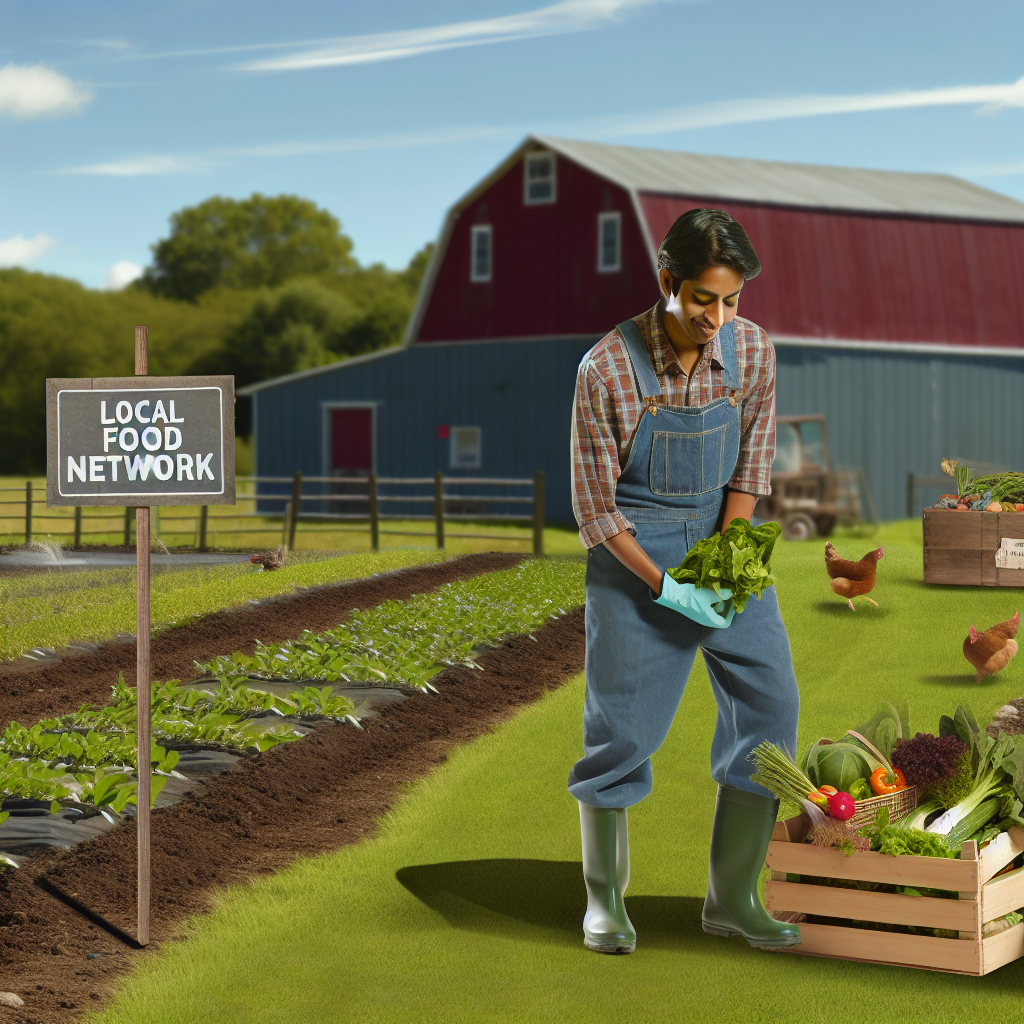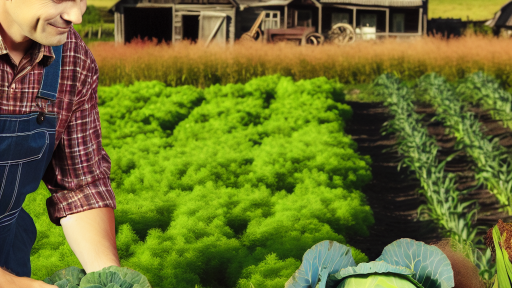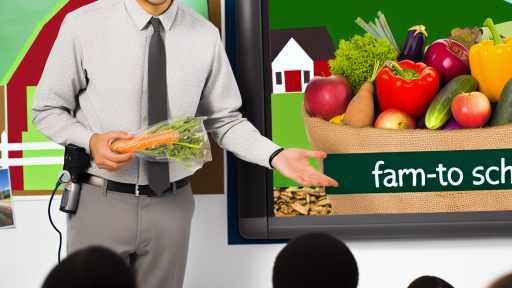Understanding the Importance of a Local Food Network
Strengthening Community Ties
A local food network strengthens ties within the community.
It fosters relationships between farmers and consumers.
Moreover, it creates a sense of belonging and shared purpose.
Enhancing Food Security
Building a local food network enhances food security.
It increases access to fresh, healthy produce.
Furthermore, it reduces dependence on distant food sources.
Supporting Local Economies
Local food networks boost local economies substantially.
They keep money circulating within the community.
This supports local businesses and creates jobs.
Encouraging Sustainable Practices
Such networks encourage sustainable farming practices.
They reduce transportation emissions and energy usage.
Additionally, they promote environmentally-friendly production methods.
Promoting Seasonal Eating
Building a local food network promotes seasonal eating habits.
People gain a better understanding of what is in season.
This not only enriches meals but also supports local farmers.
Transform Your Agribusiness
Unlock your farm's potential with expert advice tailored to your needs. Get actionable steps that drive real results.
Get StartedFostering Food Education
A local food network fosters food education among communities.
It offers workshops, farm tours, and cooking classes.
Consequently, people learn about nutrition and sustainable practices.
Assessing Your Farm’s Assets and Resources
Identifying Physical Assets
Begin by cataloging the physical assets on your farm.
This includes your land, buildings, and machinery.
Conduct an inventory of equipment and tools.
Assess the condition and usability of each asset.
Take note of any facilities suitable for events or processing.
Physical assets form the backbone of your local food network.
Understanding Natural Resources
Evaluate the natural resources available on your farm.
Soil quality plays a crucial role in your farm’s productivity.
Consider the availability of water sources for irrigation.
Identify local flora and fauna that can support a healthy ecosystem.
Natural resources can contribute to biodiversity and sustainability.
Reviewing Financial Resources
Analyze your financial capacity to enhance local food operations.
Understand your current budget and funding options.
Consider potential grants or subsidies for local agriculture.
Cultivating relationships with local investors can be beneficial.
Financial resources impact the scale and scope of your network.
Engaging with Human Resources
Identify the skills and talents within your team.
Consider the experience level of your staff members.
Foster a culture of continuous learning and development.
Consider collaborating with local agricultural experts.
Human resources are essential for implementing your vision.
Showcase Your Farming Business
Publish your professional farming services profile on our blog for a one-time fee of $200 and reach a dedicated audience of farmers and agribusiness owners.
Publish Your ProfileConnecting with Local Community
Assess your relationship with the local community.
Identify potential customers and partners nearby.
Participate in community events to build connections.
Engaging with local organizations can broaden your network.
Community support can enhance the success of your farm’s initiatives.
Building Relationships with Local Farmers and Producers
Identifying Local Farmers
Begin by researching local farms in your area.
Visit farmers’ markets to connect with producers directly.
Network through agricultural fairs and community events.
Leverage online platforms to find farmers nearby.
Consider joining local farming associations for networking opportunities.
Establishing Connections
Make introductions with local farmers over coffee or lunch.
Share your farming goals and visions with them.
Listen actively to their experiences and challenges.
Invite farmers to visit your farm to foster rapport.
Collaborate on community projects to strengthen ties.
Creating Collaborative Opportunities
Discuss potential partnerships that benefit both parties.
For instance, explore joint marketing initiatives.
Consider sharing resources such as equipment or tools.
Organize farm tours to increase community engagement.
Arrange workshops to exchange knowledge and techniques.
Building Trust and Support
Be transparent about your farming practices and goals.
Consistently communicate your needs and expectations.
Show appreciation for their contributions and efforts.
Maintain open lines of communication for ongoing support.
Foster a supportive environment that encourages collaboration.
Nurturing Long-term Relationships
Regularly check in with your farming partners.
Celebrate milestones and achievements together.
Engage in seasonal gatherings to strengthen connections.
Continuously seek feedback to improve and adapt.
Prioritize long-term relationships to enhance community resilience.
You Might Also Like: Challenges in Local Food Sourcing and How to Overcome
Identifying Your Target Market and Consumers
Understanding Your Audience
To build a successful local food network, you must understand your audience.
Your target market influences how you grow and market your food products.
Start by defining the demographics of your ideal consumers.
Consider age, income, and lifestyle choices when identifying your audience.
This will help you tailor your practices to meet their needs.
Researching Consumer Preferences
Research plays a vital role in identifying consumer preferences.
Utilize surveys and questionnaires to gather data directly from potential customers.
Additionally, review existing studies on local food trends.
Stay updated on changes in consumer behavior and preferences.
Showcase Your Farming Business
Publish your professional farming services profile on our blog for a one-time fee of $200 and reach a dedicated audience of farmers and agribusiness owners.
Publish Your ProfileListen to feedback from your community to understand their desires.
Engaging with the Community
Direct engagement with the community enhances your understanding of consumers.
Attend local events and farmers’ markets to interact with potential buyers.
Participate in community forums to discuss food needs and preferences.
Building relationships fosters trust and loyalty among your consumers.
Leverage social media to connect with your audience online and offline.
Defining Your Unique Selling Proposition
Your unique selling proposition (USP) sets you apart in the local market.
Identify what makes your farm and products unique and desirable.
Highlight specific practices such as organic farming or sustainable methods.
Communicate your values to resonate with your target audience.
Your USP should align with the interests and values of your consumers.
Segmenting Your Market
Market segmentation allows you to target specific consumer groups effectively.
Consider factors such as consumer preferences and buying behaviors.
Create segments like health-conscious buyers or families seeking convenience.
This approach helps you tailor your marketing strategies appropriately.
Personalized marketing boosts engagement and improves sales outcomes.
Find Out More: How to Start Direct Sales for Your Farm
Strategies for Marketing Local Food Products
Creating a Unique Brand Identity
Developing a unique brand identity sets your farm apart from competitors.
Consider what makes your food special and market those qualities.
Choose a compelling farm name that reflects your values.
Design an appealing logo that resonates with your target audience.
Utilize storytelling to convey your farm’s history and mission.
Utilizing Social Media Effectively
Social media platforms are powerful tools for local food marketing.
Engage with the community by sharing behind-the-scenes farm activities.
Highlight seasonal products and share recipes with your audience.
Collaborate with local influencers to broaden your reach.
Host live tours or Q&A sessions to connect with potential customers.
Participating in Farmers Markets
Farmers markets provide direct access to local consumers.
Set up an attractive booth to draw in customers.
Offer samples to showcase the quality of your products.
Provide engaging materials that explain your farming practices.
Network with other farmers to share insights and strategies.
Building Relationships with Local Restaurants
Establishing partnerships with local restaurants can drive sales.
Introduce your products to chefs who value fresh, local ingredients.
Offer flexible delivery options to accommodate their needs.
Promote farm-to-table initiatives to emphasize freshness.
Attend culinary events to connect with chefs and food enthusiasts.
Implementing a Community Supported Agriculture Program
A Community Supported Agriculture (CSA) program fosters a local food network.
Encourage customers to invest upfront in exchange for seasonal produce.
This model strengthens relationships and secures financial support.
Showcase Your Farming Business
Publish your professional farming services profile on our blog for a one-time fee of $200 and reach a dedicated audience of farmers and agribusiness owners.
Publish Your ProfileOffer customizable subscription options to meet diverse preferences.
Communicate regularly with members to share farm news and updates.
Engaging with Local Media
Local media can help amplify your marketing efforts.
Reach out to newspapers, radio stations, and bloggers.
Share your farming story and highlight unique practices.
Offer to provide expert commentary on agricultural topics.
Leverage press releases to announce events or new products.
Collaborating with Other Local Farmers
Collaboration can enhance your marketing strategy.
Organize joint events, such as farm tours or festivals.
Share resources to reduce costs and increase outreach.
Consider forming a cooperative to market your products collectively.
Exchange best practices to improve sales strategies and visibility.
Delve into the Subject: Integrating Seasonal Eating into Your Farming Operation
Creating a Community Education Program about Local Food
Identifying Community Needs
Start by assessing your community’s interest in local food.
Conduct surveys and host focus groups to gather feedback.
Engage with local residents to understand their eating habits.
Additionally, talk to schools and businesses about their food sourcing.
This information helps tailor the program to community needs.
Developing Educational Content
Create materials that emphasize the benefits of local food.
Focus on nutrition, sustainability, and supporting local economies.
Utilize a variety of formats, such as workshops, brochures, and online videos.
Incorporate interactive elements, like cooking demonstrations.
Engaging Local Partners
Connect with local farmers, chefs, and nutritionists.
Invite them to participate as guest speakers or workshop leaders.
Form partnerships with schools and community organizations.
This collaboration strengthens the local food network.
Promotion and Outreach Strategies
Use social media to promote events and share educational content.
Create a dedicated website to centralize information and resources.
Collaborate with local businesses for cross-promotion opportunities.
Consider hosting community events to attract a wider audience.
Feedback and Evaluation
Regularly collect feedback from participants to gauge effectiveness.
Adjust the program based on community responses and needs.
Set measurable goals to assess the program’s impact over time.
Celebrate successes and share stories to build momentum for local food initiatives.
See Related Content: Seasonal Agri-Tourism Ideas for Every Farm

Establishing a Distribution System for Local Products
Identifying Distribution Channels
Start by assessing local markets for distribution opportunities.
Consider connecting with community-supported agriculture programs.
Farmers’ markets provide excellent platforms for local products.
Retail partnerships with local grocery stores can expand your reach.
Additionally, explore online sales through your farm’s website.
Showcase Your Farming Business
Publish your professional farming services profile on our blog for a one-time fee of $200 and reach a dedicated audience of farmers and agribusiness owners.
Publish Your ProfileBuilding Relationships with Local Businesses
Create connections with local restaurants.
Offer them fresh produce directly from your farm.
Networking with chefs can foster long-term partnerships.
Participate in local food events to showcase your products.
Building trust is key to successful relationships.
Implementing Efficient Logistics
Develop a clear plan for product delivery.
Consider scheduling regular delivery days to local customers.
Optimize routes to minimize transportation costs.
Utilize appropriate packaging to maintain product quality.
Ensure all staff members are trained in logistics protocols.
Utilizing Technology for Distribution
Leverage technology to track orders and manage inventory.
Utilize software that streamlines order processing.
Customer relationship management tools can enhance communication.
Online platforms can simplify sales and customer interactions.
Stay updated with industry trends to maintain competitiveness.
Feedback and Improvement
Seek feedback from customers regularly.
Adjust your offerings based on customer preferences.
Monitor sales data to identify trends and optimize stock.
Incorporate suggestions to enhance customer satisfaction.
Continuous improvement reinforces customer loyalty.
Leveraging Social Media and Online Platforms for Engagement
Importance of Social Media
Social media connects farmers with their local community.
This platform allows sharing of farm updates and harvests.
Additionally, it enhances visibility for farms and local products.
Businesses can build brand loyalty through regular engagement.
Choosing the Right Platforms
Different platforms serve varied audiences and needs.
Instagram showcases visual content effectively.
Facebook facilitates community building and event promotion.
Twitter offers quick updates and industry news sharing.
Creating Engaging Content
Visual content attracts more engagement than text alone.
Share photos of your farm, crops, and community interactions.
Videos can highlight farming practices and behind-the-scenes activities.
Live streams can create real-time interaction with your audience.
Building an Online Community
Engage followers with regular posts and updates.
Respond promptly to comments and questions for transparency.
Create polls and quizzes to encourage participation.
Consider starting a blog to share experiences and insights.
Collaborating with Local Businesses
Form partnerships with local grocery stores and restaurants.
Cross-promote each other on social media platforms.
Hosting joint events can expand reach and engagement.
This enhances community support for local food systems.
Showcase Your Farming Business
Publish your professional farming services profile on our blog for a one-time fee of $200 and reach a dedicated audience of farmers and agribusiness owners.
Publish Your ProfileUtilizing Online Marketplaces
Online marketplaces provide accessible platforms for sales.
Consider using services like Etsy and local farm co-ops.
Setting up a website can allow direct customer interaction.
Promote seasonal offerings and special events online.
Evaluating and Adapting Your Local Food Network Over Time
Importance of Continuous Evaluation
Regular evaluations enhance the effectiveness of your food network.
Evaluating your network helps identify strengths and weaknesses.
It allows you to respond to changing market demands.
Key Performance Indicators to Monitor
Track participation rates of local producers and consumers.
Monitor sales growth and customer satisfaction levels.
Analyze the geographical distribution of your customer base.
Gathering Feedback from Participants
Feedback provides valuable insights into network performance.
Conduct surveys regularly to gather participant opinions.
Host focus groups to discuss challenges and opportunities.
Adapting Strategies Based on Evaluation
Use evaluation results to refine your business strategies.
Enhance marketing efforts to reach broader audiences.
Consider expanding product offerings based on consumer demand.
Building Resilience Through Partnerships
Collaborate with local businesses to strengthen your network.
Partnerships can provide additional resources and support.
Networking with other farms creates opportunities for knowledge sharing.
Staying Updated on Industry Trends
Follow food industry trends to stay competitive.
Subscribe to relevant publications and newsletters.
Attend workshops and conferences for professional development.
Long-Term Vision and Goals
Define clear long-term goals for your local food network.
Regularly revisit and adjust these goals as necessary.
Ensure all stakeholders align with the vision for success.




